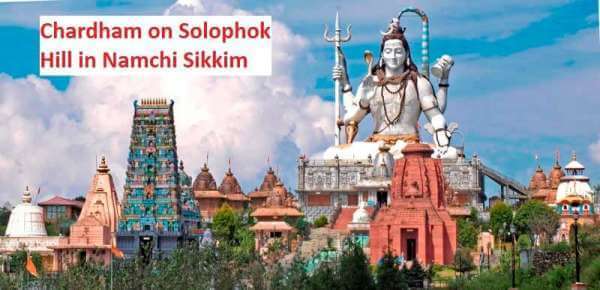Namchi is a replica of Chardham situated on the Solofok hill in Sikkim state, by combining the major pilgrimage sites of India in one place. It includes the Char Dhams located in the four corners of India, such as Rameshwaram, Somnath, Puri and Badrinath and 12 Jyotirlingas located all over India. Known as Siddheshwar Dham, the pinnacle of attraction of this place is the tall statue of Lord Shiva.
Nestled in South Sikkim, Namchi is a small town despite being the district headquarters of the South district of Sikkim. After spending some beautiful days at Baigune on the banks of river Rangit, we headed towards Namchi. The biggest attraction of our visit to Namchi was the Chardham or Siddheshwar Dham situated on the Solophok hill here. We had heard a lot about this pilgrimage site from people who had visited the hill a day before us. We were most excited to see the newly constructed complex there, which has become a favorite destination of Sikkim tourism.
Chardham or Siddheshwar Dham
History of Namchi Sikkim’s Solophok Hill
There is a chapter in the epic Mahabharata where Arjuna performs severe penance to obtain the Pashupati weapon from Lord Shiva. When Shiva was pleased with his devoted endurance, he appeared before Arjuna and granted him the boon of the Pashupati weapon. The episode is said to have happened on the Solophok hill in Namchi. I had read a book on Religious Sikkim, according to which the Chardham complex was built on this hill to mark the joy of the descent of Lord Shiva on this hill to bless Arjuna with the Pashupatiastra. The complex was inaugurated with Pran Pratishthan in the presence of Shri Jagatguru Shankaracharya Swami Swaroopanand Saraswati Maharaj and many religious dignitaries in November 2011.
Being situated on a high hill, clouds always form a part of this unique pilgrimage. While passing through these clouds, you can see the temples and the idol of Lord Shiva emerging from the clouds, giving you a glimpse back to being lost among the clouds. It appears as if God is giving you a vision before proceeding to other works. If the clouds make this place a little faint, then the flowers here fill the whole atmosphere with the vibrancy of their colors. There are so many beautiful mountain flowers all around that we kept on taking pictures of them on the way.
Chardham Complex at Namchi Sikkim
The central attraction of the Chardham complex of Namchi is the 87 feet high Shiva idol which is situated on the top of the hill. From here Lord Shiva supervises the entire Chardham complex and the valleys around it. This idol is situated at the western end of the hill facing the eastern direction. This idol is surrounded by 12 Jyotirlingas. These 12 famous Shiva temples are spread all over the religious geography of India. Every Shivling here is an exact replica of the Shivling established at its original place.
Kirteshwar
As you enter the premises of Chardham, you find the idol of Kirteshwar standing in front of you holding a bow in his hand. In Sikkim, it is believed to be a local incarnation of Lord Shiva. We get to see many old temples dedicated to Kirteshwar all over Sikkim. Kirteshwar means protector of animals.
A fountain flows in the middle of the Chardham complex, where the idols of Ganga and Yamuna standing on their respective vehicles are situated. The vehicle of Ganga is crocodile and the vehicle of Yamuna is tortoise. It is a manifestation of the confluence of the Ganges and Yamuna rivers, at Prayag.
Chardham Temples in Namchi Sikkim
These four major temples of pilgrimage in India, collectively known as Chardham, are located in the four corners of India. Badrinath in Uttarakhand, Somnath in Dwarka in Gujarat, Jagannath in Puri in Odisha and Rameswaram in Tamil Nadu. The replica of each of these dhams is here, in the Namchi town of Sikkim. According to Hindu beliefs, every person should visit these four temples at least once in his lifetime. When I look at these geographically distributed temples, these temples in themselves speak a lot of the abundance of our culture and traditions. They show that traveling is an inbuilt part of our life. That is, we have to travel to the four corners of India in our lifetime. Facts show that most of the people who go on pilgrimage travel on foot, and eventually travel across the country while walking, mingling with the many communities along the way and mingling with the nature there. This shows that the religious geography of our country binds us in a unique bond by the strong threads of religiosity.
We entered the complex of Chardham through a beautiful entrance and were welcomed by the temples surrounded by colorful flowers. We started the journey on the left side so that we could walk around the complex in a traditional clockwise manner. By doing this the entire complex will be circumambulated.
Rameshwaram Temple
Our first stop was the Rameshwaram temple, which is built in the style of Dravidian temples. It was also a little different from other temples. We entered the temple through a colorful high gopuram. We went there and prayed to Shivling. It is believed that this Shivalinga was installed by Lord Rama at Rameswaram during his return from Sri Lanka, to get rid of the guilt of killing Brahmins.
These temples are relatively simple inside and are also much smaller in size than the original temples. Despite this, these replica temples definitely give you the feeling of having a glimpse of the original temple. Going further, this path takes you to the idol of Shiva, passing through the Sai temple. The exterior of the Sai temple has an interesting structure of jaali work with red threads of vows tied around it, reminding you of the Ajmer Sharif or Chishti Dargah at Fatehpur Sikri.
Shiva idol and 12 Jyotirlingas
We saw all the 12 Jyotirlinga near the idol of Shiva. Because we saw all these Jyotirlinga one after the other, we could know and understand the subtle difference between them. For example, the Shivling in Kedarnath is just a hump of stone, but the one in Rameshwaram is built in a square yoni in the style of South India. There is a small notice board which shows the story of each Shivling. A Sanskrit shloka summarizes the geography of these 12 Jyotirlingas through a short poem.
The time had come to take darshan from near the idol of Shiva. The incarnations of the goddesses were excavated around the big platform on which Shiva was sitting. Standing in front of Shiva, you suddenly feel small and you naturally bow down to his power. Below this idol is a Shiva temple, where chapters of Shiva Purana are depicted. It includes everything from the marriage of Lord Shiva, to Lord Shiva carrying the dead body of Mother Sati after Prajapati Daksha’s Yagya, to the penance performed by Mother Parvati to get Shiva. There is a group of priests who perform satsang and kirtan daily in the temple with their musical instruments.
Jagannath Puri Temple
The next temple was the temple of Jagannath Puri, where Krishna lived with Balarama and Subhadra. The idols here are also impressive replicas of the idols of their original place.
Badrinath Temple
The best one was preserved for the last darshan, i.e. the colorful Badrinath temple. I have not been to Badrinath yet but the architecture of this temple and its colorful furnishings gave me another reason to visit Badrinath. Me and my camera both of us were completely immersed in the bright colors of the Badrinath temple of Chardham.
Every single moment spent in Chardham was the most beautiful moment. This Chardham Yatra was much more beautiful and beyond our expectations. Chardham is highly commendable in terms of quality, size and maintenance.
Visiting Chardham or Siddheshwar Dham, as it is officially called, is like traveling across India. These pilgrimage centers bind the whole of India in such a bond that political boundaries have no meaning for them. This destination of reverence and faith defines the boundaries of India.


